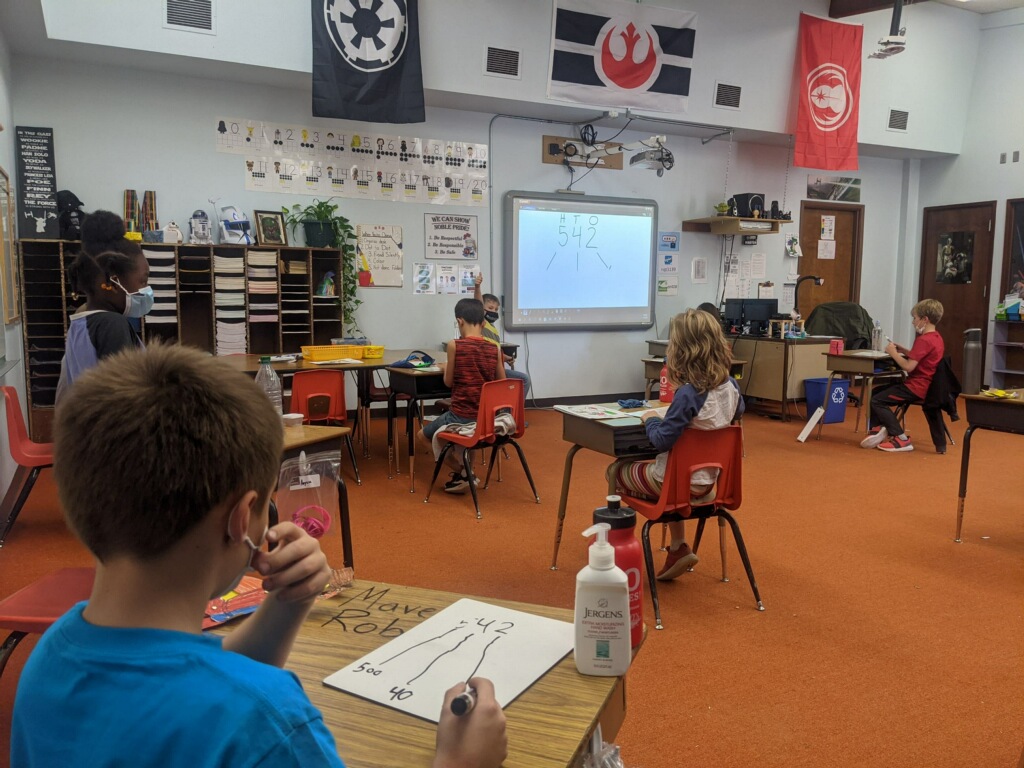
Teacher Austyn McNew's second-grade class at Fort Vannoy Elementary School in Grants Pass, Ore.
Austyn McNew
With school districts grappling with difficult questions about opening schools to in-person instruction, the science of COVID-19 transmission among kids is especially necessary right now.
Fortunately, we seem to have this aspect of the global pandemic figured out. The bulk of studies show that kids are about half as likely to become infected with the coronavirus as adults, something researchers noted during the outbreak’s early days.

Dr. Dawn Nolt is the medical director for infection prevention at OHSU Doernbecher Children's Hospital.
OHSU
“That’s something that, thankfully, we seem to have gotten right from the very beginning,” says Dr. Dawn Nolt, pediatric infectious diseases specialist with OHSU Doernbecher Children’s Hospital.
The data has huge implications for Oregon, where most public school students are still not able to return to in-person instruction, something Nolt believes is important for the overall health of children.
“We have an overarching goal of child health, [which] we know includes good education,” Nolt says. “When we talk about when to start and when to continue in-person education, we should remember that kids don’t drive COVID-19 infection in the community.”
Nolt spoke with OPB Morning Edition host Geoff Norcross. Some highlights:
Geoff Norcross: How likely are children to get the virus in the first place?
Dawn Nolt: The preponderance of studies suggests that kids are approximately half as susceptible to getting the virus as adults. There was a nice review published in October that looked at 14 other studies, and they showed that kids under 10 years of age were significantly less likely to get infected compared to the other members of their household.
Norcross: If a kid gets the virus, how likely are they to get sick from it?
Nolt: Kids show minimal, if any, symptoms from COVID-19. If they do get sick, it’s the usual COVID symptoms we hear about, such as cough, fever, fatigue and loss of smell. If they do get sick, they’re much less likely to have serious problems compared to older individuals.
Norcross: How likely are kids to pass the virus on to others if they get it?
Nolt: The impression from early studies in the pandemic [is] that kids seem to be less contagious than adults. And we’re also seeing an age differential in that the younger kids, such as those less than 10 to 12 years of age, don’t pass the virus very efficiently to other adults.
Norcross: How has our understanding of the infectiousness of kids changed since March, if at all?
Nolt: That’s something that, thankfully, we seem to have gotten right from the very beginning. We understand how viruses work in kids. We have established patterns. We understand how it can spread from a child into the community. And we know this pattern particularly well in influenza, that kids can drive the infection rates in schools and in communities. But when the COVID-19 pandemic started and continues to run, we’ve consistently noticed that we’re not seeing the pattern that children are driving the transmission rates in the community.
We still, of course, advise kids to wear masks and wash your hands and physically distance as much as possible. But they don’t seem to be the factor that’s driving the transmission rates in the community.
Norcross: From your perspective, as a pediatrician and as an infectious diseases specialist, what do you think all this means for this very difficult question of whether to open schools to in-person instruction?
Nolt: We have an overarching goal of child health, [which] we know includes good education. So in the discussion about in-person education, we should show the data that kids are less likely to become sick. And if they do get sick, they’re less likely to pass it on to others. And that these observations seem particularly true in the younger children, such as those that are in primary grades.
When we talk about when to start and when to continue in-person education, we should remember that kids don’t drive COVID-19 infection in the community, at large or within schools, particularly if they’re wearing masks.
Click on audio player at the top of this story to hear the whole conversation.
Kids, do you have questions about the virus or COVID-19? Leave us a voicemail at 503-977-7768, or send a voice memo to gnorcross@opb.org.




